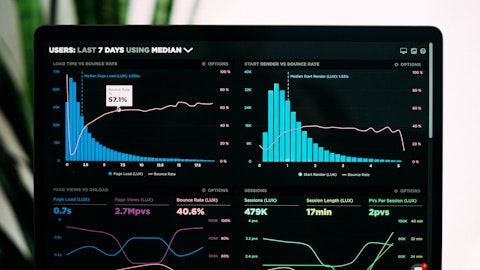In this article, we look at the 50 largest economies in the world in 2023. To skip our detailed analysis, head directly to the 10 Largest Economies in the World in 2023.
Gross Domestic Product (GDP) is the market value of all finished goods and services produced in a country within a specific time period. The GDP can help gauge the health and size of a country’s economy. The world’s total output was estimated to be above $100 trillion in 2022. A report by the United Nations has projected global GDP to grow at 2.3% in 2023 and 2.5% in 2024. Prospects of economic recovery from the effects of Covid-19 pandemic remain dim amid rising interest rates, high inflation, and global uncertainties. Russia’s invasion of Ukraine has further complicated matters.
The United States is the largest economy in the world, which is expected to grow by 1.1% in 2023. China’s GDP growth is forecasted at 5.3%, while Europe’s economies are projected to grow by a mere 0.9% this year.
A report released by the McKinsey Global Institute highlighted the impact of corporations on the global economy in the 21st century. It was found that the business sector contributed 72% of the gross domestic product (GDP) in OECD member nations. Companies that have more than $1 billion in annual revenue contribute the major chunk in that percentage. In 2017, about $14 trillion of the United States’ then GDP of $20 trillion was coming from the corporate sector. Cargill, which is the largest privately held corporation in the U.S., had a revenue of $165 billion in 2022 – a staggering amount that is greater than the GDP of some entire nations. Publicly listed companies like Apple Inc. (NASDAQ:AAPL), Microsoft Corporation (NASDAQ:MSFT), Amazon.com, Inc. (NASDAQ:AMZN), Lockheed Martin Corporation (NYSE:LMT), and General Electric Company (NYSE:GE) also play a significant role in retaining the U.S.’s status of the largest economy in the world.
Apple Inc. (NASDAQ:AAPL) recorded a revenue of $394 billion in 2022. Earlier this year in March, Microsoft Corporation (NASDAQ:MSFT) reported a 9% increase in profits for the first quarter of 2023 – $18.3 billion, or $2.45 per share. In the defense sector, Lockheed Martin Corporation (NYSE:LMT) is the largest defense contractor in the world that produces billions of dollars worth military equipment for countries around the world. You can read more on Lockheed Martin Corporation (NYSE:LMT) in Top 16 Defense Contractors in the World in 2023.
The last couple of decades, however, have witnessed the beginning of a radical shift in global economic power from advanced countries towards emerging markets. Economic growth in the developing and emerging countries has been 5.8%, on average, since the year 2000, which is considerably higher than the mean 1.8% seen in the advanced nations during the same period. Economies of the Emerging 7, or E7 countries, were half the size of the G7 countries in 1995, and in 2015, both groups were relatively the same size. By 2040, the E7 economies are expected to be twice the size of G7. This is discussed in detail in our article, the 25 Most Powerful Countries in the World in 2023.
Asian Century
The 21st century has also been dubbed by economic experts as the Asian Century. China and India are already among the top five largest economies in the world. China is the second largest economy in the world after the United States. India now boasts an economy nearing $4 trillion and hosts global tech giants like Apple Inc. (NASDAQ:AAPL), Microsoft Corporation (NASDAQ:MSFT), Alphabet Inc. (NASDAQ:GOOG), and Twitter that employ thousands. According to the World Economic Forum (WEF), Asia, which is home to nearly half of the world’s population, is likely to generate more than 50% of the world’s GDP by 2040. The continent accounts for nearly one-third of the world’s total trade, up from about a quarter a decade ago. China and India have been forecasted by the PwC to become the two largest economies of the world in 2050, going past the United States. European Union’s share of the global GDP is likely to reduce to a mere 9%, with France expected to be out of the top 10, and Italy out of the top 20 largest economies in the world. Indonesia is also projected to be among the top seven largest economies of the world in 2050. Vietnam and Philippines are expected to take strides as well in the coming decades. Pakistan may become the sixth largest economic power by 2075, according to The Goldman Sachs Group, Inc. (NYSE:GS).
Methodology
We have used nominal GDPs of countries to rank the 50 largest economies in the world in 2023. Data has been sourced from the International Monetary Fund (IMF). The GDP numbers are from 2022.
Here are the largest economies in the world in 2023:

dibrova/Shutterstock.com
50. Portugal
GDP: $252 billion
We begin our list with Portugal, a southern European country that borders Spain. The country’s economy has bounced back from the pandemic-induced recession. The growth has been driven by strong domestic demand and resumption of tourism in the country. Portugal’s GDP is expected to grow by 2.4% in 2023.
49. Iraq
GDP: $270 billion
Iraq recorded a GDP growth of 8% in 2022. One of the main reasons for this was the country’s 12% increase in oil output, as noted by IMF, and high oil prices around the world, which provided much needed respite to the Iraqi economy.
48. Finland
GDP: $281 billion
Finland had a GDP of $281 billion in 2022. The country’s 60% of exports are to members of the European Union, with Germany and Sweden being its largest trade partners. Finland experienced a mild recession in 2022, because of which, economic growth is expected to remain low in the first half of 2023.
47. Czech Republic
GDP: $290 billion
Czech Republic made the list of the largest economies in the world in 2023 due to the size of its GDP, which was measured at $290 billion in 2022. Economic growth, however, is expected to decline, from 2.5% in 2022 to 0.2% in 2023. Inflation is expected to decelerate from 14.6% in 2022 to 11.9% in 2023. It is also one of the 20 largest economies in Europe.
46. Chile
GDP: $301 billion
Chile had a GDP of $301 billion and a growth rate of 2.4% in 2022. The economy is expected to grow slightly in 2023, driven by exports, especially lithium and copper. Inflation has been projected by the World Bank to remain high in the short term. Poverty will remain around 11.5%.
45. Romania
GDP: $302 billion
Romania had a robust GDP growth of 4.2% in 2022, with the size of its economy measured at $302 billion by the IMF. This was driven by increased investments and private consumption. The country has a GDP per capita of $14,643. More than 1,800 Romanians work for Microsoft Corporation (NASDAQ:MSFT). In 2022, Microsoft Corporation (NASDAQ:MSFT) announced to open its first data center in Romania.
44. Colombia
GDP $344 billion
Colombia’s economy grew at 7.3% in 2022 but has overheated due to activity beyond its potential, said the World Bank. It is projected to slow down and grow by a mere 1.7% in 2023. However, growth is expected to increase to 2% in 2024 and 3.2% in 2025. Crude petroleum, coal, and coffee are the country’s main exports.
43. Iran
GDP: $352 billion
Despite economic sanctions and an inflation rate of 42.5%, Iran’s economy is projected to grow by 2.2% in 2023. However long-term prospects of the economy look gloomy with no revival of a nuclear deal in sight.
42. Hong Kong
GDP: $361 billion
Hong Kong’s economy shrank by 4.1% in the last three quarters of 2022, but has staged a recovery in 2023, driven by an increase in tourism and local spending. The government’s GDP growth forecast for 2023 is between 3.5-5%, and Hong Kong is well on track to achieve it.
41. Pakistan
GDP: $376 billion
Pakistan is the fifth most populous nation in the world, with its youth bulge being the driving force of the economy. However, security and political turmoil in the last decade has pegged the country back from reaching its full potential. In 2023, Pakistan risks facing default with its foreign exchange reserves critically low and revenues shrinking. You can read more on it in our list of the top companies in Pakistan.
40. Denmark
GDP: $391 billion
Denmark received a ‘stable’ outlook from Fitch and was forecast to narrowly avoid technical recession in 2023. The OECD has projected a growth rate of 0.1% this year and for inflation to fall from 8% to under 3% by 2024. It has also been regarded as one of the best countries to start a business, owing to its relatively low corporate tax rate of 22%. In addition, Copenhagen is considered the logistics hub in the Nordic region, providing access to 100 million Scandinavian customers within 24 hours. For this reason, the country attracts a lot of shipping businesses catering to Nordic countries.
39. Philippines
GDP: $404 billion
Philippines is on track to become an upper middle-income economy, according to the country director for Asian Development Bank (ADB). Its economy is expected to grow 6% in 2023 and climb further by 6.2% in 2024. PwC’s report titled ‘The World in 2050’ has projected that Philippines will be among the 20 largest economies in the world by 2050.
38. South Africa
GDP: $406 billion
Scheduled power cuts that started in 2007 have constrained South Africa’s economic growth. This has disrupted economic activity by increasing operating costs for businesses. The Covid-19 pandemic further exacerbated the country’s woes. According to the World Bank, there were half a million fewer jobs in 2022 than in 2019. Despite these challenges, South Africa remains an economic power in the African continent.
37. Vietnam
GDP: $407 billion
Vietnam’s GDP grew by 8% in 2022. That has slowed down in 2023 to 3.3% in the first quarter. This is due to the ongoing recession in the European Union and the United States – two key trade partners that account for 40% of Vietnam’s exports, according to S&P Global. However, Vietnam is expected to resume rapid economic growth as it remains a key southeast Asian manufacturing hub.
36. Malaysia
GDP: $408 billion
The Malaysian economy continues to thrive and recorded a GDP growth of 5.6% in the first quarter of 2023, which was higher than some of the other prominent countries in the neighborhood, such as Indonesia, China, and Vietnam. Malaysia’s GDP is projected to rise from $408 billion in 2022 to $780 billion by 2032 – an increase of 90% in a decade.
35. Bangladesh
GDP: $460 billion
Bangladesh’s economy is expected to grow by 5.3% in 2023, which is the third highest growth rate among South Asian countries after Maldives and India. In 2021, the country surpassed India on per capita income, and has an 80% higher per capita GDP than Pakistan – the country it took independence from in 1971.
34. Singapore
GDP: $467 billion
Singapore is a high-income economy and boasts a gross national income per capita of over $64,000 according to the World Bank. Singapore is a major international financial hub, and its currency, the Singapore Dollar, is among the 15 Most Powerful Currencies in the World – accounting for nearly 1.8% of all foreign exchange trading daily. The Goldman Sachs Group, Inc. (NYSE:GS) has announced building a forex trading hub in Singapore in collaboration with JPMorgan Chase & Co. (NYSE:JPM).
33. Austria
GDP: $472 billion
Strong domestic demand is likely to help Austria recover from its current economic downturn. According to the OECD, Austria’s GDP growth is expected to be 0.2% in 2023, and then 1.6% in 2024. Economic forecasts suggest real wages to rise and inflation to ease in the ongoing fiscal year.
32. Egypt
GDP: $475 billion
Egypt had a GDP of $475 billion in 2022 with an economic growth of 6.6%. However, this growth is expected to decline in 2023 to 4.5% according to the World Bank. Inflation is expected to remain in double digits, surpassing the government’s target range between 5-9%.
31. Nigeria
GDP: $477 billion
Africa’s biggest economy Nigeria has the largest gas reserves in the continent, and proven crude oil reserves of 37.1 billion barrels. World Bank has projected the Nigerian economy to grow by an average of 2.9% between 2023 and 2025. The country had a GDP of $477 billion in 2022.
30. United Arab Emirates
GDP: $507 billion
The United Arab Emirates economy is the second largest in the Arab world. The GDP was estimated to have grown by 7.6% in 2022 – the highest expansion in 11 years – and growth prospects are expected to remain above 7% in 2023 as well. The country has recovered sharply from the slowdown induced by Covid-19 and the government plans to double the size of the economy by 2031.
29. Israel
GDP: $523 billion
Israel ranks among the countries that spend the highest on research & development and is widely recognized in the world as a leader in innovation. In 2022, it had a nominal GDP of $523 billion, and a GNI per capita of about $50,000.
28. Ireland
GDP: $530 billion
Ireland had the fastest growing economy in Europe in 2022 with a GDP growth of 12.2%, driven by higher private consumption, investments by multinationals, and continued growth in exports. According to the IMF, it had a GDP of $530 billion in 2022.
27. Thailand
GDP: $536 billion
After easing travel restrictions in May 2022, Thailand has seen a surge in international tourism arrivals. This has resulted in rebounding the country’s economy and helped it recover from effects of the Covid-19 pandemic. The Thai economy has grown by 2.7% in the first quarter of 2023, compared with 1.4% in the final quarter of 2022.
26. Norway
GDP: $579 billion
Norway had a GDP of $579 billion in 2022. The country derives much of its wealth from energy resources and is one of the world’s largest exporters of oil. Norwegian oil giant Equinor ASA (NYSE:EQNR) is one of the leading suppliers of energy to Europe and operates in 36 countries.
25. Belgium
GDP: $582 billion
Belgium hosts the headquarters of NATO and the European Union, making it one of the most politically influential countries in the world. It is a developed economy and had a GDP of $582 billion in 2022. According to OECD’s economic outlook for Belgium, the country is forecast to have a GDP growth of 0.9% in 2023 which will rise to 1.4% in 2024. Inflation this year is set to decrease due to falling energy prices.
24. Sweden
GDP: $586 billion
Sweden is a Scandinavian country with a GDP of $586 billion in 2022, ranking 24th on our list based on economic data released by the IMF. However, the country is going through recession and the economic outlook for 2023 was described by the Swedish government as ‘gloomy’ in as early as October last year. According to reports, the economy is set to contract by 1% instead of the projected 0.7% figure.
23. Argentina
GDP: $632 billion
Argentina is the third largest economy in South America behind Brazil and Mexico but is going through one of the worst economic crises in its history. Annual inflation rate soared past 100% in April 2023 – the third highest in the world after Venezuela and Zimbabwe. The country’s central bank has hiked interest rates to 97% with the hope that this measure will incentivize investments in the local currency.
22. Poland
GDP: $688 billion
Poland has been one of the most affected countries due to Russia’s invasion of Ukraine because of a large influx of refugees and increased energy prices, which have taken a toll on the Polish economy and dimmed hopes of a post-pandemic recovery. Poland’s GDP growth has crashed from 5.1% in 2022 to a projection of 0.7% in 2023. However, EU forecasts expect economic growth to rebound in 2024 to 2.7%.
21. Taiwan
GDP: $762 billion
Taiwan, located at the junction of the East and South China Seas, had a GDP of $762 billion in 2022. In 2021, its GNI per capita was reported at just under $35,000. Taiwan’s economic growth has remained consistently high for several decades now and is referred to as one of the four ‘Asian Tigers’ alongside Singapore, South Korea, and Hong Kong.
20. Switzerland
GDP: $807 billion
Switzerland is one of the largest economies in Europe and is known for its banking and finance sector. The Swiss Franc is the 8th most traded currency in the world in the foreign exchange market. Switzerland is one of the world’s wealthiest countries and acts as a ‘safe haven’ for financial investors during times of instability.
19. Türkiye
GDP: $906 billion
With an output of over $900 billion, Türkiye’s economy is the 19th largest in the world in terms of nominal GDP. The country is a member of the G20 and OECD. Despite the fact that the Turkish Lira has lost 60% of its value against the U.S. Dollar since 2021, the Turkish economy remains strong and grew by 5.2% in 2022. However, the devastating earthquakes that occurred this year inflicted direct losses exceeding $34 billion, adding pressures to the country’s macro-financial situation.
18. Netherlands
GDP: $994 billion
Netherlands’ economy is close to touching $1 trillion. Despite having a population of only 17 million, it is one of Europe’s strongest economies. Dutch multinational company Koninklijke Philips N.V. (NYSE:PHG), or Philips, is headquartered in Amsterdam. The economy, like other countries in the region, is likely to slow down, from a GDP of 4.3% in 2022 to 0.8% in 2023.
17. Saudi Arabia
GDP: $1.1 trillion
Saudi Arabia is the 17th largest economy in the world with a GDP of over $1 trillion. The kingdom is a permanent and founding member of OPEC, and one of the biggest oil exports globally. Saudi Arabia’s share of oil exports in total exports increased from 71% in 2021 to 79% in 2022. The Saudis are leveraging their economic power to modernize their military as well. The country was the fifth biggest defense spender in 2022 having spent a whopping $75 billion on military expenditure that year. You can read more on this in our article, the 25 Most Powerful Militaries in the World in 2023.
16. Indonesia
GDP: $1.31 trillion
Indonesia with a GPD of $1.31 trillion in 2022 is the biggest economy in southeast Asia and one of the emerging market economies. It is also part of the G20. Indonesia is expected to be the fourth largest economy in the world in 2050 as per projections by PwC.
15. Spain
GDP: $1.4 trillion
Spain is an economic powerhouse in Europe with a GDP of $1.4 trillion. The country’s economic growth however is likely to decline from 5.5% in 2022 to about 1% in 2023. Investors are confident of a rebound soon because the Spanish economy has not been hit as badly as some other European nations from Russia’s war on Ukraine. This is due to Madrid’s focus on specialized production and less reliance on the Ukrainian and Russian economies.
14. Mexico
GDP: $1.41 trillion
Mexico is tipped to be seventh largest economy in the world in 2050 by PwC. The South American nation currently boasts a GDP nearing $1.5 trillion. It has a growing influence in North America and is one of the biggest exporters in the Latin America region. Tourism is thriving in the country; over 18 million visitors flocked to Mexico in 2022.
13. South Korea
GDP: $1.65 trillion
South Korea is Asia’s fourth largest economy by nominal GDP and among the fastest growing emerging markets in the world. It registered a GDP growth rate of 2.6% in 2022, which is expected to decline in 2023 to 1.6% due to recession in the U.S. and EU, and a slowdown in the electronics industry. Last year, South Korea had a GDP of $1.65 trillion.
12. Australia
GDP: $1.7 trillion
Australia experienced its slowest GDP growth in over a year and a half in the first quarter of 2023. The GDP rose by only 0.2% as high inflation and interest rates impacted consumer spending. Earlier this year, KPMG had also forecasted the Australian economy to slow down in 2023, but keep away from recession. Despite challenges, it is one of the world’s largest economies, and its currency, the Australian Dollar, is the premiere currency of the Asia-Pacific region.
11. Brazil
GDP: $1.92 trillion
Brazil ranks 11th in our list of the 50 largest economies in the world in 2023. The size of the Brazilian economy is closing in on the $2 trillion mark. Given its substantial land, resources, and population, the South American nation is poised for further economic growth in years to come. PwC has projected Brazil to be the fifth largest economy in the world in 2050.
Click to continue reading and see the 10 Largest Economies in the World in 2023.
Suggested Articles:
- 20 Largest Economies in Europe
- 25 Most Powerful Countries in the World in 2023
- 15 Most Powerful Currencies in the World
Disclosure: None. 50 Largest Economies in the World in 2023 is originally published on Insider Monkey.





